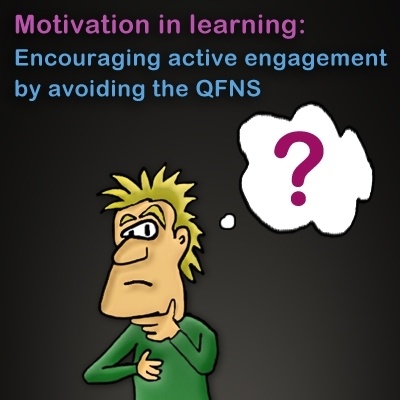Motivation in Learning
In education it is our job to facilitate the development of the necessary knowledge, skills and attitudes for people to successfully perform in their duties, or in preparation for future opportunities.
For the successful transference of the learning to occur it is obvious that active engagement from the learner is necessary. It is therefore important for a learner's undivided attention to be focused on building the new competencies at all times throughout the learning process.
As this article is original content written by myself and most of my recent L&D experience has been around E-learning, I shall be slightly angling my analysis toward E-learning for business purposes. But the core message of what I say - can in fact be thought about and applied with relevance to pretty much any Learning and development project.
The 'Quick Fix Non-Solution'
Ok, so one of the things I think that plagues the L&D world is the 'Quick Fix Non-Solution'. I have come across this in different forms via my extensive research and also through some of my real world encounters. So what do I mean by 'Quick Fix Non-Solution' (QFNS)? Well ironically sometimes E-learning itself could be classed as a QFNS. If for instance an organization's solution for improving their L&D program was a straight conversion of all materials directly into a digital E-learning format without any strategy as to how this would improve performance of the learning involved, then this could very well be considered a QFNS. The reason being is that the solution would have no targeted value, with the platform being leveraged in a vague hope that it will be beneficial. M-learning seems to be one of the current trends that could very quickly become a QFNS for many companies if they do not carefully identify the particular benefit leveraged by the platform, by conducting a thorough training needs analysis.

I believe a second example of QFNS is a notion I have witnessed being professed about the method by which active engagement is acquired. Most people in the L&D community will have heard of a 'page turner', an E-learning course that you could quite easily click through without even really concentrating. There is a solution I have read far too many times for supposedly ensuring that a course is not a 'page turner', which is to include an animation or an interaction every so often and then mix up the types of interaction so as to keep things varied and fresh. In essence there is a definite reasoning behind the concept, in the sense that this 'MTV' generation are often not able to concentrate for as long as previous generations. But I think the question has to be asked as to whether bombarding the learner with hyper intensive interactive graphical wizardry really promotes a positive and active engagement? Or when adopted as a QFNS without any involved strategy, is this solely getting the person's attention whilst missing out on the very important task of engaging the active learner within?So now perhaps the question needs to be asked as to why I have described the things above as QFNS. Well it's simple, sourcing new technologies and fanciful presentations are exciting and might very well make the education seem cutting edge, and in fact both factors can and will improve training when implemented as part of a well researched and thought out strategy. But when implemented on their own as a sweeping 'one size fits all' solution they fall flat, because in essence the most important part of any learning, is the learner themselves. A learner has to be motivated to want to learn. A learner must also be engaged throughout the learning, which means you have to understand who your learners are so that you can appeal to them on a personal level. Essentially a strong training needs analysis should be conducted before any course approach is decided, not only to align the business drivers with the learning objectives but also to understand the learner as a person. Because at the core of that person's existing knowledge, their needs, and desires is the true direction for developing a strong learning solution.

Marketing the education
Marketers have long known the importance of understanding people, but in education we have to go even deeper. For with marketing the notion is generally to understand a person's desires and then create materials, which leverage those desires towards profit. Learning however is a much more prolonged and challenging prospect than the simple transaction of money for goods. Also the need for learning as an asset towards fulfilling people's desires might not be as apparent to most potential learners as the simple purchase of objects and services are. This is why as educators we must understand the psychology and the sociology behind why a person might be enticed to want to learn. We must research our target group each time and find out enough about them for us to gain insight as to how we can package our solution to appeal to their desires and make the process simple enough to warrant their effort. Only then can we truly work towards motivating and engaging our learners with skills, knowledge and attitudes that they will retain long after the learning has taken place.
Thank you for reading; I hope that you enjoyed this article. If you have any experiences or insights that relate to this subject, then please feel free to voice your opinion in the comments below.








